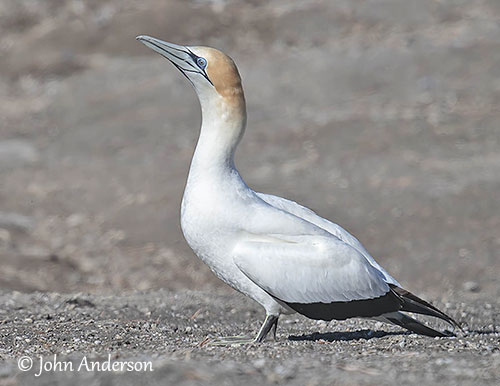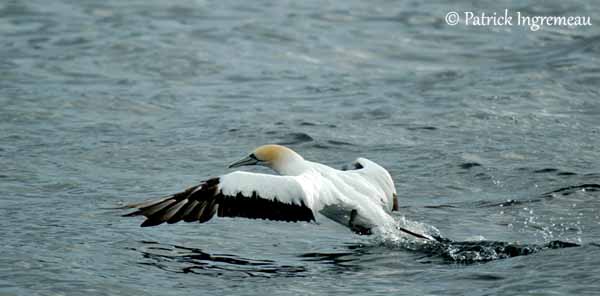
Fr: Fou austral
All : Australtölpel
Esp : Alcatraz Australiano
Ital : Sula australiana
Nd: Pacifische Jan-van-gent
Sd: Australisk sula
Photographers:
John Anderson
John Anderson Photo Galleries
Patrick Ingremeau
TAMANDUA
Text by Nicole Bouglouan
Sources:
HANDBOOK OF THE BIRDS OF THE WORLD vol 1 by Josep del Hoyo-Andrew Elliot-Jordi Sargatal - Lynx Edicions - ISBN: 8487334105
BirdLife International (BirdLife International)
Birds in backyards (Birds Australia and Australian Museum)
Wikipedia, the free encyclopaedia
Australasian Gannet
Morus serrator
Suliformes Order – Sulidae Family
BIOMETRICS:
Length: 84-91 cm
Wingspan: 160-170 cm
Weight: 2350 g
DESCRIPTION:
The Australasian Gannet is the third member of genus Morus. It is very similar to Northern Gannet and Cape Gannet.
The adult has white plumage overall, except on black primary flight feathers, and broad black tips to secondary flight feathers. The tail shows four black central rectrices, whereas outer ones are white. The black gular stripe is short, as in Northern Gannet.
The head is buff-yellow. The stout bill is pale blue-grey with black base and cutting edges. The eyes are pale bluish-white, surrounded by deeper blue eyering than in other Morus. Lores are black. Legs and webbed feet are black, with pale greenish toes.
Both sexes are similar.

Juvenile is dark brown first, and the white plumage growths gradually through mottled phases. It can breed at 5-6 years.
VOICE: SOUNDS BY XENO-CANTO
The Australasian Gannet gives loud, raucous calls at colonies and when feeding in groups at sea. Male and female utter the same type of sounds.
HABITAT:
The Australasian Gannet is strictly marine. It can be seen flying over the continental shelf or coastal waters. It breeds on open offshore islets.
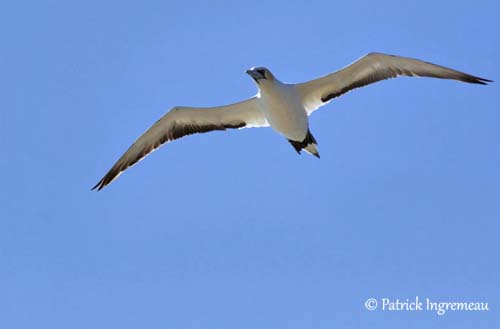
REPRODUCTION:
The breeding season occurs between October and May. The Australasian Gannet is highly seasonal.
It nests on the ground, usually in small but dense colonies. The nest is made with grass and seaweeds, forming a rough mound. Nest materials are held together by droppings.
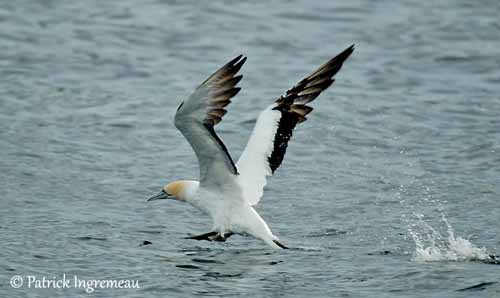
The female lays a single egg, rarely two. Incubation by both parents lasts 44 days. The chick has whitish skin covered with white down. It is fed by both adults and fledges about 100 days after hatching.
DIET:
The Australasian Gannet feeds on pilchard, anchovies, jack mackerel and squid, caught by plunge-diving.
PROTECTION / THREATS / STATUS:
The Australasian Gannet has been persecuted during the first half of the 20th century, but today, populations are slowly increasing.
This species is not currently threatened in spite of reduced breeding range.
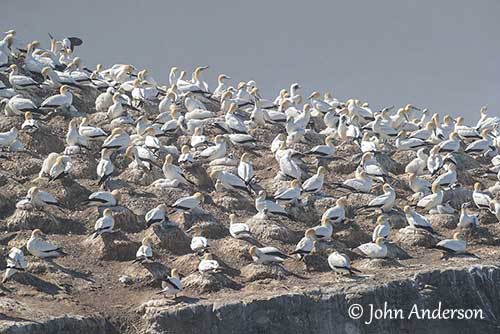
Displays are similar to that of other gannets. These birds always are beautiful and graceful in their movements, but they can become aggressive against neighbours at colonies when defending the nest-site.
The Australasian Gannet remains in the vicinity of the colony after the nesting period. The young disperse and may cover more than 2500 km in a week. Large numbers follow W and E Australian coasts northwards.
The population of New Zealand disperse W across Tasman Sea to S Australian waters.
FLIGHT:
The Australasian Gannet performs powerful and agile flight, mainly when fishing and diving steeply.
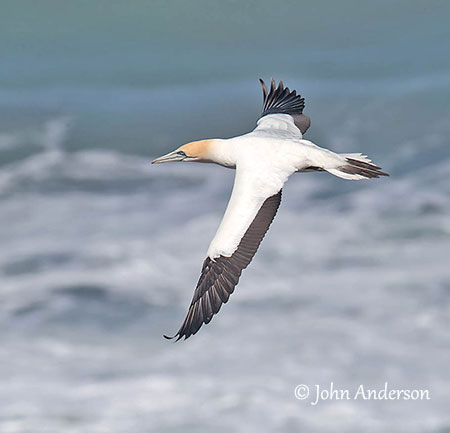
RANGE:
The Australasian Gannet occurs along the coasts of SE Australia, Tasmania and New Zealand where it breeds.
This species winters on adjacent waters and up W and E Coasts of Australia.
BEHAVIOUR:
The Australasian Gannet feeds on pilchard (Sardinops neopilchardus), anchovies (Engraulis australis) and mackerel (Trachurus novaezelandiae), some other fish species and squid (Nototodarus).
As other Sulidae species, it performs plunge-diving into the sea from some height. It regularly follows trawlers for debris.
